Each edition here uses a different set of rules, and are not exactly compatible with each other.
Fifth Edition (2000)
This edition of Gamma World was designed for the Sci-fi game Alternity. I'll have much more to say about that when I do my review and deep dive into Alternity later this month.
But like all the Alternity titles, this one is out of print and unavailable from DriveThruRPG. Thankfully, I still have my own copy.
This edition is notable for also (like the 3rd Edition) not being compatible with the then-current edition of Dungeons & Dragons. This one appeared at the end of the AD&D 2nd edition era and right before the D&D 3.0 era.
Omega World (2002)
This was an adaptation of the d20 rules to play a Gamma World-like mini-game. It appeared in Dungeon Magazine #94 and was a stand-alone affair. It is the odd child of the Gamma World family, and that is saying something, but it is a rather fun game in a tight little package.
This requires the D&D 3.0 game to play, not the d20 Modern Rules which would not be released for another month or so.
Along with Ravenloft, Wizards of the Coast had Arthaus, an imprint of White Wolf, create the d20 Edition of Gamma World. This was a fairly robust edition with both a Player's Handbook and a Game Master's Guide. A Machines and Mutants book was also released, mimicking the classic three book format D&D has always used.
That is not the only way it mimicked D&D. This version of Gamma World used the d20 Modern rules, making it to this point the most compatible with the then-current D&D (3.5). It also made it compatible with all of Wizard's of the Coast's d20 Future line, which included some materials from both Alternity and Star Frontiers. It was also compatible with WotC's d20 Star Wars.
The book titles are a little misleading. The Player's Handbook has the setting information. Character creation and most of the rules are still in the d20 Modern book, needed to play. The Game Master's Guide is less about running a Gamma World game and more about running any sort of RPG. The Machines and Mutants book, aka the Monster Manual, is pretty much what it says it is.
Wizards of the Coast sought cohesion in the Alternity line, which they achieved by accident in the d20 era. This also means that the Omega World game is 100% (or 95-99%) compatible with this.
In truth, this is a solid edition that makes some solid attempts at updating the Gamma World mythology to better suit 21st-century technology and genetics.
While it is not perfect, it is very playable and it was always in the back of my mind when I tried out various d20 sci-fi games.
Seventh Edition (2010)Gamma World came back again, and this time in-house at Wizards of the Coast. Gamma World 7th Edition was built on the same rules as D&D 4th Edition, and they are quite compatible in that respect. Gamma World characters tend to be more powerful and more random as befitting the nature of the genre.
I know the least about this game. Though I did watch some people play it at Gen Con 2011 when it was released, and it looked fun, I'm not sure it felt like Gamma World to me. But I don't deny the people playing it had a good time.
If Gamma World 6e was a serious grimdark post-apoc setting, then this one returned to its weird roots. I think this is one of the reasons I like 6e better than 7e. Also, I think the D&D4 rules, while I am fine with them for D&D4, don't click with me here. The cards seemed a step too much for me. Though I am equally certain I could mine this for ideas.
--
All editions though can be great fun, if you are willing to ignore the fact that levels of radiation talked about in these games would just kill everyone and not really make them mutants. But that is why they are Science Fantasy and not Science Fiction per se. None of that matters, though; the real reason here is to play a radioactive plant ape that speaks in a Cajun accent and swings a stop sign as a weapon.

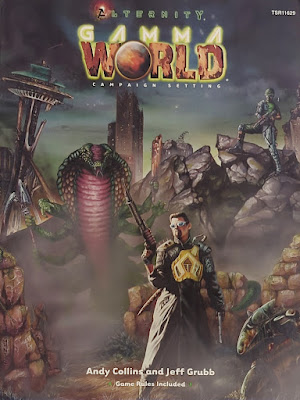
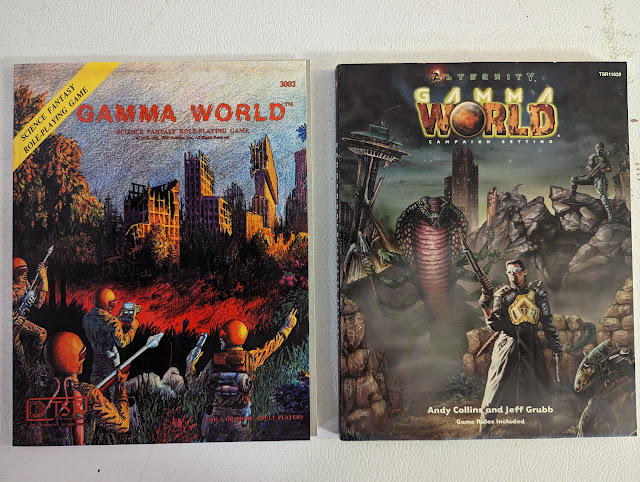
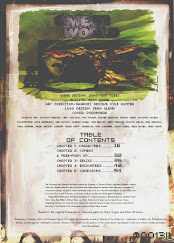
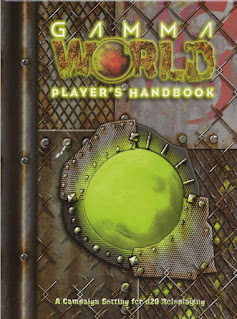
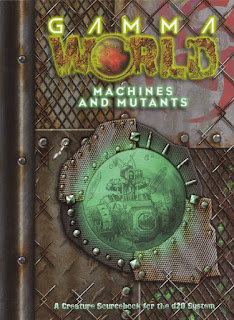
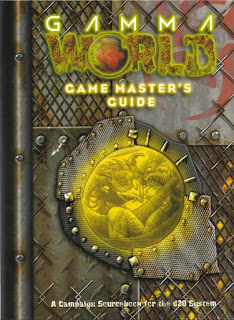
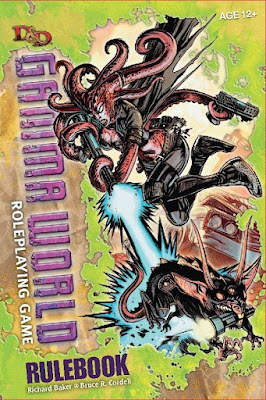
Haha! Love that mental image you capped this off with. I’ve always had a vague interest in the successive editions of this game, since I used to roll up characters (and never actually play) from the first edition when I was a kid. Nice to have your overview here.
ReplyDeletePretty common to hear people say that D&D 4e would have been much less controversial if it had been called anything but D&D, since the game itself was fine but nothing like what that brand implies.
ReplyDeleteGW 7th edition arguably has the same problem. If it had been called something else it might have done better, and the GW branding may actually have hurt what was a fundamentally decent tongue-in-cheek post-apocalypse game. The random-packed cards were a tiresome attempt to milk a bit of extra money, but if they'd been a fixed set in the box or just a random table they'd have been fine. This is by far the most gonzo edition (which is saying something) and doesn't take itself seriously, but if you treat it like Paranoia - something light to play in small doses as a break from other games, not a long-term campaign - I think it works just dandy. Just don't expect it to be much like any other GW ever.
Are you going to be able to review the Delphian Edition (based on 5e)?
ReplyDelete